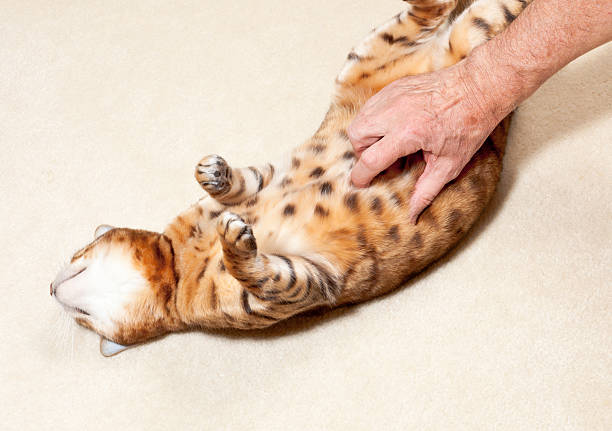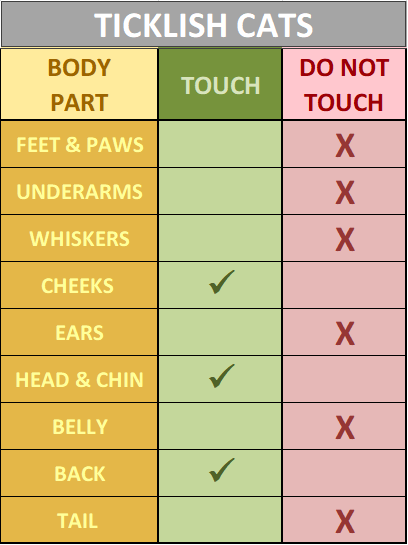
If you are ticklish and laugh out loud just by thinking about it, you have gargalesis – a specific type of laughter triggered by tickling. But what about cats? Are they ticklish too? Is gargalesis present in cats?
Just like some people, certain cats are more ticklish than others. However, unlike us, our feline friends do not respond to tickling with laughter simply because they are not capable of expressing joy through smiles. The scientific term for the tickling sensation in pets is called knismesis.
So, in general, cats can be ticklish but depending on whether they like the activity, kitties can either respond by purring and meowing or hissing and biting. Therefore, before starting to tickle your cat for fun, make sure she enjoys it.
HOW CAN I TELL IF MY CAT IS TICKLISH?
There is no way to tell unless you check. Naturally, all cats are ticklish, but some more and others less. Also, some felines enjoy it, and others hate it. Plus, it is not uncommon for cats that disliked tickling to develop an interest in the activity and vice versa – for kitties that loved it to suddenly start being annoyed when their humans tickle.
WHERE ARE THE CAT’S TICKLISH SPOTS?
When testing your cat’s ticklishness, there are various hot spots or usually sensitive areas you need to pay extra attention to. Depending on how your furry baby reacts, you should either focus on these areas or avoid them completely.
Are the cat’s feet and paws ticklish?
When it comes to tickling, the extra sensitive feet and paws are a big no-touch. Same as people, cats dislike having their feet and paws touched and tickled. In cats, this might be linked with survival, as these body parts are essential for hunting.
Are the underarms sensitive too?
In terms of the region under the arms, cats and humans are once again similar. Namely, most cats are tickling-sensitive under their arms, so these areas are best left untouched during the session.
What about the cheeks and whiskers?
While the whiskers are a big no-go for touching, most cats actually enjoy having their cheeks tickled. Of course, this may not be the case with cats suffering from periodontal disease or other pain-causing oral issues.
Is the ear region prone to ticklish feelings?
Definitely, yes – the ears are rich in nerve endings and one of the most sensitive body parts, not just in cats, but pets in general. While rubbing the base of the ear is linked to increased production of “feel good” hormones, tickling them is annoying for most furry babies.
Or maybe the head and chin?
Now, these are some of the few body parts cats like being tickled. Almost all cats enjoy head rubs, and the chins can be special too. Namely, cats have glands in their chin, and if they allow tickling, they leave their scent on you (something like marking you as their own), by rubbing themselves.
What about the belly?
Trying to tickle your cat’s belly is a recipe for disaster. Cats are not small dogs, and they definitely do not like belly rubs. Just touching your kitten’s belly can make her scream in panic or even fight back and scratch.
Do cats like their backs tickled?
Most cats like it when humans tickle or massage their backs. This is the reason why most felines enjoy long grooming sessions and brushing. However, once again, every cat is different and may react individually.
How about their tails?
The tail is a big variable – while some cats do not mind having their tails touched and tickled, others love it, and of course, there are those that feel petrified by the idea. You can gently try touching the tail, and the kitty will let you know how it feels about it.
ARE ALL CATS EQUALLY TICKLISH?
The mentioned ticklish sensation, or better said, knismesis, does not depend on breed, age, and gender.
However, logically speaking, hairless (Sphynx) and short-haired (Bengal, Bombay, Abyssinian) felines should be more ticklish than cats with long coats (Manx, Maine Coon, American Bobtail).
Similarly, tickling might be more suited for playful young kittens than senior cats with arthritis pain and other age-related health conditions.
However, these are just logical assumptions. The truth is every cat can be ticklish, and the exact level varies among individuals and is a question of personality.
WHY DO CATS MOVE WHILE BEING TICKLED?
Cats can move during tickling because of two main reasons – they either enjoy the session too much or hate it and try to escape.
In the first scenario, the cat moves because she wants to participate in the activity and rub herself even stronger. In the second case, your kitty is looking for a way out as she probably does not like it or the session was too long.
HOW DO CATS RESPOND TO BEING TICKLED?
Same as with people, some cats respond to tickling with happiness and others with anger. It is also possible for the session to be enjoyable only if it does not last for too long.
To know whether to continue or stop touching the sensitive areas, you need to be familiar with the cat’s basic positive and negative reactions. Namely, a cat that likes being tickled will show the following signs:
- Purr, meow, or make other pleasure-related sounds
- Be calm and relaxed, with closed or slightly open eyes
- Hold her ears backward.
On the other hand, a cat in distress by the tickling will:
- Hiss, scratch, and bite
- Escape and hide
- Hold her ears erected
- Wag with the tail.
There are also some reactions to tickling that are neither positive nor negative. Instead, they are due to reflexes. For example, if gently tickling a kitty under the ear, she might move or even paddle with the hind leg. Similarly, if using pet wipes to clean your cat’s private areas after visiting the litter box, she may respond by twitching the ears.
HOW TO TICKLE MY CAT SAFELY?
There is no universally accepted tickling method and instruction guide. Each cat is different, and finding the right approach will probably take some experimentation (you can expect to earn a few scratches along the way if hitting a bad spot).
Before tickling your cat, make sure you know her well. Knowing how your feline friend reacts in different situations will help read her body language. It is advisable to start with short sessions and to tickle a different body part every time.
Over the course of several days, you will know which body areas are safe for titillating and which make your cat feel nervous and uncomfortable. For safe interaction, make sure you only touch the approved body parts (otherwise, prepare to pay the price – the above-mentioned scratches).
WHEN SHOULD I STOP TICKLING MY CAT?
When tickling your cat or performing any interactive activity, it is critical to monitor your kitty’s reaction and read her body language. The cat will let you know when it is game over time – you just need to pick up the subtle clues.
To put it bluntly, you should titillate your cat for as long as she enjoys it. However, it is critical to stop the moment your feline friend shows it is feeling uncomfortable (but before the kitty gets angry and defensive).
Although there is no risk of over-tickling your cat, not stopping in time can make your cat anxious and may start to dislike the activity in the future.
HOW CAN I MAKE MY CAT HAPPY?
Tickling your cat can be a pleasant experience for both and a good way of spending quality time together and strengthening the human-kitty bond. However, if your cat is too ticklish and not a big fan of this activity, do not worry – there are plenty of other ways to make your cat happy.
For example, instead of tickling, if you want to make your feline friend feel loved and appreciated, you can bake her favorite homemade cat treats. You can also spend more quality time together – playing interactive games and snoozing on the sofa. Investing in various cat toys is another amazing alternative.
Share and Pin!

CONCLUSION
All in all, it is safe to say that cats are ticklish. However, some cats are more ticklish than others. We often associate being titillated with a funny but slightly unpleasant activity. If your cat feels the same, do not force it, but if she likes it, the tickling session can be a good bonding activity.
Finally, if your cat suddenly becomes extra ticklish all of a sudden, make sure she is not suffering from a medical condition that causes skin irritation and itchiness. In such cases, your cat does not like the tickling and she is basically using you to scratch her itch.
Happy Cat Care!
Please Share Your Thoughts in the Comments Below!
